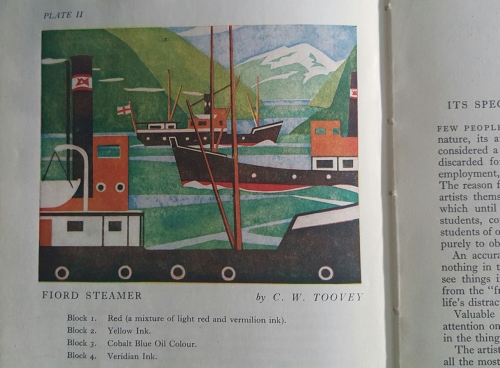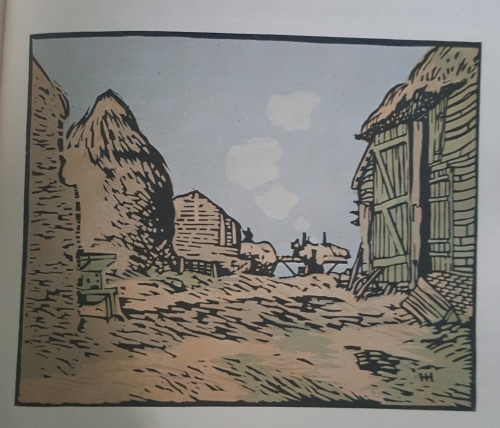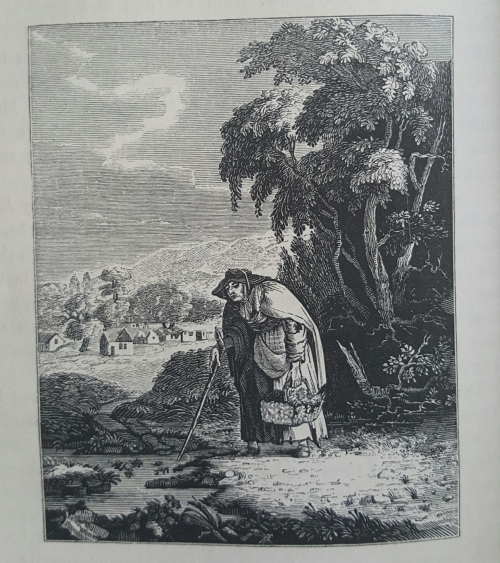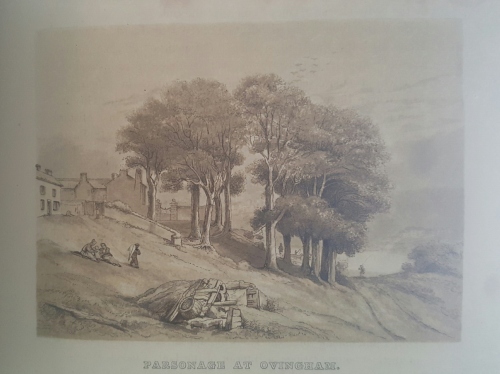 It was at an exhibit at the Met a few years ago that I learned, much to my amazement, that linoleum block prints weren't just an art students' thing, or a kids' project. The linoleum block prints in the exhibit were from a sophisticated school of art practiced in England in the 1920's and 30's. I was really taken with the prints, most of which were about 12" x 15" or thereabouts. They had real power. The experience of seeing them was one of those serendipitous moments when you turn a corner in a gallery and say "Wow." The exhibit included a book in a glass case that had been written by Claude Flight, one of the leaders of the movement, about making color linoleum prints. I took down the details and located a copy; since then I located another contemporary text on the subject. Unlike most of the later texts on the subject, these two books tried to teach how to make professional grade prints of quality and complexity. It was at an exhibit at the Met a few years ago that I learned, much to my amazement, that linoleum block prints weren't just an art students' thing, or a kids' project. The linoleum block prints in the exhibit were from a sophisticated school of art practiced in England in the 1920's and 30's. I was really taken with the prints, most of which were about 12" x 15" or thereabouts. They had real power. The experience of seeing them was one of those serendipitous moments when you turn a corner in a gallery and say "Wow." The exhibit included a book in a glass case that had been written by Claude Flight, one of the leaders of the movement, about making color linoleum prints. I took down the details and located a copy; since then I located another contemporary text on the subject. Unlike most of the later texts on the subject, these two books tried to teach how to make professional grade prints of quality and complexity.
I haven't actually tried doing this myself - I can't draw. But it's important to understand that the medium, in this case linoleum, very much shapes the form of the piece. Nowadays you can duplicate just about any style with Adobe Illustrator, but you can't easily duplicate the rules enforced by a medium, or in the case of block printing, the depth and dimension of something actually printed on a block in a press.
A quick search on google immediately comes up with hundreds of modern linoleum images, most in just B+W, but some in color.
 I also happen to have in my book collection "Treatise on Wood Engraving" by John Jackson, with two additional engravings by Baxter. The book, which was published in 1839, is the gospel of woodcut engravings, written at a time when the art form was at its technical peak. The book is sometimes found with the Baxter prints removed, since the prints are valuable on their own. George Baxter (1804-1867) was the first person in England who managed to produce color wood engravings in any quantity. He used a variety of techniques and the last image in this blog, "Parsonage at Ovingham" is by him. (Apologies for the mediocre reproduction.) I also happen to have in my book collection "Treatise on Wood Engraving" by John Jackson, with two additional engravings by Baxter. The book, which was published in 1839, is the gospel of woodcut engravings, written at a time when the art form was at its technical peak. The book is sometimes found with the Baxter prints removed, since the prints are valuable on their own. George Baxter (1804-1867) was the first person in England who managed to produce color wood engravings in any quantity. He used a variety of techniques and the last image in this blog, "Parsonage at Ovingham" is by him. (Apologies for the mediocre reproduction.)
Why do it in the first place? That question can actually be asked of any craft endeavor, or any activity, really. Why carve? Why make furniture? Why decorate a cake? The actual urge to make stuff is intensely personal, primal, and way more complicated than can be addressed here. But unlike furniture or carving, block printing can allow you to create multiples. With good paper and ink, block printing gives you a result that is unlike any modern printing. The bags we use for the BT&C nails are printed on a letterpress, using ink blocks for the graphics, and pressure to stamp the ink onto the paper. We do it this way mostly because we need to cut and score the bags for folding, but the result, with depth to the letters, is so satisfying to the touch, that even if we didn't need to score anything we would still use letterpress.
You don't need a printing press - although building a small press out of wood is pretty easy, and the actual carving is well within the ability of just about everyone. Any hand printed item - a business card, an invitation, a thank you card - printed with your own block is a far more personal form of communication than the laser printed equivalent.
For those of you who might be interested in giving it a go, the basic idea is pretty simple: carve, in reverse, the pattern you want to print. Actually, that's not true. Unlike engraving, where you remove material where a line goes, in linoleum printing you carve away all of the top surface that doesn't print. The skill comes in leaving clean lines remaining, and carving in a way so that the thinner lines remaining, and the edges or the printed parts, have strength and won't collapse under the press. (I know it's more complicated than that, and the final result is the printed paper, not the carved printing block, which is just the vehicle.) You do need sharp tools, of course. Printing the blocks also requires some basic skill which can be easily learned.
 We recently started stocking a linoleum block cutting kit by Flexcut and block printing supplies, which I hope will become popular. We also stock a large selection of "Block cutters" by Ashley Iles. Most of the block cutting tools we sell are used by carvers who happen to like the smaller tools, but it's gratifying to know that we do have a fair number of print makers amongst our customers. We recently started stocking a linoleum block cutting kit by Flexcut and block printing supplies, which I hope will become popular. We also stock a large selection of "Block cutters" by Ashley Iles. Most of the block cutting tools we sell are used by carvers who happen to like the smaller tools, but it's gratifying to know that we do have a fair number of print makers amongst our customers.
I would hate to think that all the traditional methods of printing will get swept away by the computer.
The main picture at the top of this blog is from "Lino Cutting and Printing" by Claude Flight (1934) and the second print is from "Colour Block Print Making from Linoleum Blocks" by Hesketh Hubbard (1927). This is the final proof print after the book works its way step by step through all the plates, printing each color one by one.
The second to last picture, a wood engraving from the early 19th century, is by Jackson and is from his book.
As someone who collects books I can say that part of the appeal for me of 18th century and earlier books is the physical beauty of early printed engravings, woodcuts, and the way the letters are embedded in the page.
 N.B. You might have noticed that in the past months I am blogging considerably less. I would much rather blog less than just publish endless drivel, and in the past months, continuing to the present, we have been remodeling our entire space. We now have a passenger elevator, and we expect to add Saturday hours by the fall. This means that while we reorganize, my toolboxes and carving bench have been moved to a corner, and I am loath to start doing anything useful because the entire shop is at sixes and sevens. I'm also changing my role at TFWW. Over the coming months I will be doing less day-to-day management and more computer work (which is actually my main area of expertise) and more woodworking content. I realized that unless I stopped working on day-to-day problems I would never get a chance to resume making stuff - which is the reason I ended up in this industry in the first place. N.B. You might have noticed that in the past months I am blogging considerably less. I would much rather blog less than just publish endless drivel, and in the past months, continuing to the present, we have been remodeling our entire space. We now have a passenger elevator, and we expect to add Saturday hours by the fall. This means that while we reorganize, my toolboxes and carving bench have been moved to a corner, and I am loath to start doing anything useful because the entire shop is at sixes and sevens. I'm also changing my role at TFWW. Over the coming months I will be doing less day-to-day management and more computer work (which is actually my main area of expertise) and more woodworking content. I realized that unless I stopped working on day-to-day problems I would never get a chance to resume making stuff - which is the reason I ended up in this industry in the first place.
|
 Joel's Blog
Joel's Blog Built-It Blog
Built-It Blog Video Roundup
Video Roundup Classes & Events
Classes & Events Work Magazine
Work Magazine


 It was at an exhibit at the
It was at an exhibit at the  I also happen to have in my book collection
I also happen to have in my book collection  We recently started stocking a linoleum block cutting kit by Flexcut and block printing supplies, which I hope will become popular. We also stock a large selection of
We recently started stocking a linoleum block cutting kit by Flexcut and block printing supplies, which I hope will become popular. We also stock a large selection of  N.B. You might have noticed that in the past months I am blogging considerably less. I would much rather blog less than just publish endless drivel, and in the past months, continuing to the present, we have been remodeling our entire space. We now have a passenger elevator, and we expect to add Saturday hours by the fall. This means that while we reorganize, my toolboxes and carving bench have been moved to a corner, and I am loath to start doing anything useful because the entire shop is at sixes and sevens. I'm also changing my role at TFWW. Over the coming months I will be doing less day-to-day management and more computer work (which is actually my main area of expertise) and more woodworking content. I realized that unless I stopped working on day-to-day problems I would never get a chance to resume making stuff - which is the reason I ended up in this industry in the first place.
N.B. You might have noticed that in the past months I am blogging considerably less. I would much rather blog less than just publish endless drivel, and in the past months, continuing to the present, we have been remodeling our entire space. We now have a passenger elevator, and we expect to add Saturday hours by the fall. This means that while we reorganize, my toolboxes and carving bench have been moved to a corner, and I am loath to start doing anything useful because the entire shop is at sixes and sevens. I'm also changing my role at TFWW. Over the coming months I will be doing less day-to-day management and more computer work (which is actually my main area of expertise) and more woodworking content. I realized that unless I stopped working on day-to-day problems I would never get a chance to resume making stuff - which is the reason I ended up in this industry in the first place.